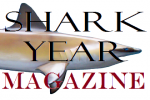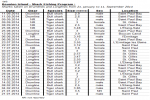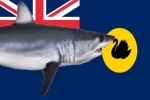Status of angelshark, Squatina squatina, in the Sea of Marmara
Status of angelshark, Squatina squatina (Elasmobranchii: Squatiniformes: Squatinidae) in the Sea of Marmara Hakan Kabasakal, Özgür Kabasakal ABSTRACT: On 4 January 2014, a female specimen of Squatina squatina was entangled in trammel-net, at a depth of about 50 m. The specimen was 174 cm long (total length) and weighed approximately 35 kg. The recent single
Population structure and residency patterns of whale sharks at a provisioning site in Cebu
Published on 16. September 2014 Population structure and residency patterns of whale sharks, Rhincodon typus, at a provisioning site in Cebu, Philippines Gonzalo Araujo, Anna Lucey, Jessica Labaja, Catherine Lee So, Sally Snow, Alessandro Ponzo ABSTRACT: This study represents the first description of whale sharks, Rhincodon typus, occurring at a provisioning site in Oslob, Cebu,
Cebu: Amended PB ordinance shields shark from extermination
Provincial News Cebu Provincial Government 16. September 2014 —————————– By Ramon Gallardo The once dreaded creature in the sea, the shark, which man fears to encounter specially during a sea mishap, human being now seems shifted his notion to this kind of animal as a mere predator – to its importance to our marine biodiversity.
29th Shark killed on Drumline in Reunion Island
Helmut Nickel (mail), Shark Year Magazine, 15. September 2014 Shark Fishing Program in Reunion Island: Two bull sharks and three tiger sharks harvested in less than a week, already 29 large sharks killed since January. In the early morning hours of last thursday, 11. September, two large bull shark were taken by fishermen working for
Quantifying Shark Distribution Patterns and Species-Habitat Associations
Published on 10. September 2014 Quantifying Shark Distribution Patterns and Species-Habitat Associations: Implications of Marine Park Zoning Mario Espinoza, Mike Cappo, Michelle R. Heupel, Andrew J. Tobin, Colin A. Simpfendorfer ABSTRACT: Quantifying shark distribution patterns and species-specific habitat associations in response to geographic and environmental drivers is critical to assessing risk of exposure to fishing,
WA Drumlines: EPA recommends against extending shark catch and kill policy
Media Statement Environmental Protection Authority (EPA) 11. September 2014 —————————- EPA recommends Shark Hazard Mitigation Drum Line proposal should not be implemented Summary: The Environmental Protection Authority has today announced it has recommended the Western Australian Shark Hazard Mitigation Drum Line Program 2014-2017 proposal should not be implemented. Release Date: 11 September 2014 Details: Following
Risk assessment of cartilaginous fish populations
Published online on 08. September 2014 Risk assessment of cartilaginous fish populations Enric Cortés, Elizabeth N. Brooks, Kyle W. Shertze ABSTRACT: We review three broad categories of risk assessment methodology used for cartilaginous fish: productivity-susceptibility analysis (PSA), demographic methods, and quantitative stock assessments. PSA is generally a semi-quantitative approach useful as an exploratory or triage
Movements and habitat use of reef manta rays off eastern Australia
Published online on 09. September 2014 Movements and habitat use of reef manta rays off eastern Australia: offshore excursions, deep diving and eddy affinity revealed by satellite telemetry F. R. A. Jaine, C. A. Rohner, S. J. Weeks, L. I. E. Couturier, M. B. Bennett, K. A. Townsend, A. J. Richardson ABSTRACT: Manta rays (Manta
Sharks in Acidic Waters Avoid Smell of Food
Media Release Georgia Institute of Technology 09. September 2014 —————————- Writer: Brett Israel The increasing acidification of ocean waters caused by rising atmospheric carbon dioxide levels could rob sharks of their ability to sense the smell of food, a new study suggests. Elevated carbon dioxide levels impaired the odor-tracking behavior of the smooth dogfish, a
Odor tracking in sharks is reduced under future ocean acidification conditions
Published online on 11. August 2014 Odor tracking in sharks is reduced under future ocean acidification conditions Danielle L. Dixson, Ashley R. Jennings, Jelle Atema, Philip L. Munday ABSTRACT: Recent studies show that ocean acidification impairs sensory functions and alters the behavior of teleost fishes. If sharks and other elasmobranchs are similarly affected, this could
Man dead after Fatal Shark Attack at Byron Bay – NSW Australia
Man attacked by shark at Byron Bay Sydney Morning Herald, September 9, 2014 A man has died following a shark attack at Byron Bay on the New South Wales far north coast, paramedics say. A NSW Ambulance spokeswoman said the man died on Clarkes Beach just after 11am. Witnesses called triple-0 at 10.42am on Tuesday
NOAA: Stock Status Determination for Atlantic Sharpnose and Bonnethead Sharks
DEPARTMENT OF COMMERCE National Oceanic and Atmospheric Administration RIN 0648–XD476 — Stock Status Determination for Atlantic Highly Migratory Atlantic Sharpnose and Bonnethead Sharks A Notice by the National Oceanic and Atmospheric Administration on 09/05/2014 AGENCY: National Marine Fisheries Service (NMFS), National Oceanic and Atmospheric Administration (NOAA), Commerce. ACTION: Notice. SUMMARY: This action serves as a
Unprovoked Shark Bites: Are They Becoming More Prevalent?
Published online on 05. September 2014 Unprovoked Shark Bites: Are They Becoming More Prevalent? Daryl McPhee ABSTRACT: An unprovoked shark bite is an extremely infrequent, but highly disturbing hazard for water sport participants in many parts of the world. Information was analysed on the total number of unprovoked shark bites between 1982 and 2011. In







